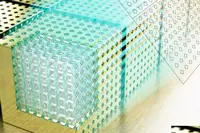Electronics News
Archive : 22 November 2015 год
 Toshiba has developed a next generation TarfSOI (Toshiba advanced RF SOI) process optimised for radio-frequency (RF) switch applications.
Toshiba has developed a next generation TarfSOI (Toshiba advanced RF SOI) process optimised for radio-frequency (RF) switch applications.
According to Toshiba RF switch ICs fabricated using the new TaRF8 process are able to achieve an insertion loss of just 0.32dB at 2.7GHz. Compared to products using Toshiba’s current TaRF6 process, the insertion loss has been improved by 0.1dB while maintaining the same level of distortion characteristics.
Designed for use in smartphones, the SP12T RF switch IC features an integrated MIPI-RFFE controller for mobile applications. The device is suitable for use in devices compliant with 3GPP GSM, UMTS, W-CDMA, LTE and LTE-Advanced standards.
With the trend in mobile communications towards high data rate, high-capacity data transfers, RF switch ICs used in mobile devices and smartphones, require multi-port support and improved RF performance. Lowering insertion loss is recognised as a particularly important factor in this, as it decreases RF transmission power loss, which can support a longer battery life for mobile devices.
Sample shipments of SP12T RF switch ICs fabricated with the new process will start in January 2016.
Author
Neil Tyler
Source: www.newelectronics.co.uk
 Electronic soldering and bonding materials supplier, Alpha has announced a collaborative partnership with the National Graphene Institute (NGI) at The University of Manchester to develop the next generation of graphene-based electronic materials.
Electronic soldering and bonding materials supplier, Alpha has announced a collaborative partnership with the National Graphene Institute (NGI) at The University of Manchester to develop the next generation of graphene-based electronic materials.
James Baker, graphene business director at The University of Manchester said: "This collaboration is another significant step forward to realising the next generation of graphene-based electronic materials and Alpha are a welcome addition to our ever expanding partnerships with industry.”
The collaboration is a multi-year effort which will focus on how to utilise innovative soldering materials in applications which have higher connectivity, mobile and sustainability requirements, which will have an impact on electronics assembly and packaging as well as energy and power industries.
Richard Ertman, president of Alpha added: “We look forward to the many innovative and new technologies and applications for graphene in our products and marketplaces.”
Graphene is expected to revolutionise the energy sector. The NGI is a centre of graphene research and commercialisation, where academics and their industrial partners can work side by side on the applications of graphene. The University currently has more than 40 commercial partners and more than 235 researchers on graphene and related 2D materials and The NGI is funded by The Engineering and Physical Sciences Research Council and The European Regional Development Fund.
Pic: James Baker, graphene business director at The University of Manchester
Author
Tom Austin-Morgan
Source: www.newelectronics.co.uk
 Analogue and sensor specialist, ams has acquired CMOSIS in a €220million deal. According to ams, the acquisition will expand its optical sensor portfolio and market leadership in the Industry 4.0, IoT and medical diagnostics markets.
Analogue and sensor specialist, ams has acquired CMOSIS in a €220million deal. According to ams, the acquisition will expand its optical sensor portfolio and market leadership in the Industry 4.0, IoT and medical diagnostics markets.
CMOSIS’ image sensors serve a range of high-end applications in diverse markets including machine vision, medical, broadcast, traffic, scientific and photographic imaging. In addition, CMOSIS offers the award-winning NanEye miniature camera module line for endoscopy-like medical applications.
Kirk Laney, CEO of ams said: “Integrating cameras with advanced optical sensors will drive new sensor solutions across vertical markets and accelerate our growth plans as we combine CMOSIS’ leading edge IP and design capabilities with our manufacturing competence and optical sensor strengths.”
The expected full year 2015 revenues of CMOSIS is said to be approximately €60million with year-on-year revenue growth in 2016.
Luc de Mey, CEO of CMOSIS, added: “We are excited to join ams creating a leader in advanced imaging solutions. We will leverage ams’ technical and operational expertise and profit from the global access to potential new customers to realise our full growth potential.”
The transaction is expected to close within the next six weeks subject to certain regulatory approvals and the occurrence of certain conditions defined in the agreements with the sellers of the CMOSIS shares.
Pic: Kirk Laney, CEO of ams
Author
Tom Austin-Morgan
Source: www.newelectronics.co.uk
 Digi-Key Electronics has announced an exclusive, global agreement to distribute software and design data from Accelerated Designs. Accelerated Designs focuses on providing EDA-tool-neutral software and data to engineers and electronics manufacturers that improves the efficiency of adding and managing new parts when designing circuits and printed circuit boards.
Digi-Key Electronics has announced an exclusive, global agreement to distribute software and design data from Accelerated Designs. Accelerated Designs focuses on providing EDA-tool-neutral software and data to engineers and electronics manufacturers that improves the efficiency of adding and managing new parts when designing circuits and printed circuit boards.
Randall Restle, Digi-Key vice-president of application engineering, said: “Digi-Key is extremely pleased to sign Accelerated Designs as a supplier.This means engineers can obtain libraries of symbols and footprints for hundreds of thousands Digi-Key’s parts, indexed with a Digi-Key part number, and compatible with your EDA tool.”
Accelerated Designs’ Ultra Librarian uses the concept of templates to create parts, which is claimed to increase the accuracy, speed, and consistency of part creation and allows global changes to be made to your library. It also allows the user to build their component accurately one time and then export it to a CAD tool of their choice. Additionally, Accelerated Designs is said to provide the industry’s’ largest library of components with 7.2million parts.
Restle added: “Manufacturers supplying Digi-Key now have a partner that can help reduce a barrier in customers adopting their new devices.By virtue of working with Accelerated Designs to build libraries of symbols and footprints of their newest devices, Digi-Key will automatically distribute those design assets for them.”
Author
Tom Austin-Morgan
Source: www.newelectronics.co.uk
 At the halfway stage of a four year project intended to build a European-based supply chain in silicon photonics, PLAT4M says it has now developed three technology platforms and adds these are available to a range of fabless companies.
At the halfway stage of a four year project intended to build a European-based supply chain in silicon photonics, PLAT4M says it has now developed three technology platforms and adds these are available to a range of fabless companies.
PLAT4M, which has received €10.2million of EC funding, brings together 15 companies, including European R&D institutes, CMOS companies, industrial and research organisations, and end users.
The supply chain is based on technology platforms from Leti, imec and STMicroelectronics, supported by a unified design environment.
Imec’s platform is based on SOI substrates with 220nm crystalline silicon on a 2µm buried oxide. During the project, the fabrication processes and integration flow have been fine tuned to have stable and repeatable performance for all photonics building blocks and the platform is already being used by Thales, Polytec and TNO.
Thales has demonstrated a coherent combination of laser beams and intends to produce high power, high energy laser sources for sensing, industry or fundamental physics.
Leti has developed a new photonic platform, based on 200mm SOI wafers. Multilevel silicon patterning allows the design of various passive and active devices with thermal tuning capability. Leti and III-V Lab have developed integrated hybrid III-V lasers and electro absorption modulators. A clear eye diagram has been achieved at 25Gbit/s, confirming strong potential for telecom applications, says the project.
Meanwhile, ST has developed a 300mm silicon photonic platform, which will be used as a proof of concept R&D tool. During its development, ST has demonstrated wavelength division multiplexing solutions, some of which are designed for the 100GBase-LR4 standard.
Author
Graham Pitcher
Source: www.newelectronics.co.uk
 Texas Instruments has added the CC1310 wireless microcontroller to its SimpleLink portfolio. The sub GHz device is said to enable extended battery life, longer range and enhanced integration.
Texas Instruments has added the CC1310 wireless microcontroller to its SimpleLink portfolio. The sub GHz device is said to enable extended battery life, longer range and enhanced integration.
Featuring an ARM Cortex-M3 core and a sensor controller, the device is said to have the ability to communicate over distances as far as 20km.
Running at up to 48MHz, the part is supplied with 128kbyte of in system programmable flash, an 8kbyte SRAM cache and 20kbyte of ultra low leakage SRAM. Operating from a supply in the range from 1.8 to 3.8V, it has a receiver sensitivity of -124dBm and a programmable output power of up to 14dBm. Consuming 0.6µA in sleep mode, the device is said to have a ULPBench score of 158.
Suited for operation in 315, 433, 470, 500, 868, 915 and 920MHz ISM bands, the CC1310 will be available in 4 x 4, 5 x 5 and 7 x 7mm QFN packages. In the first phase of the launch, devices for 868, 915 and 920MHz operation are available.
Author
Graham Pitcher
Source: www.newelectronics.co.uk
 Scientists at the University of Twente's MESA+ research institute have developed a manufacturing method to create 3D nanostructures. This discovery is claimed to make it possible to produce chips with additional functions for mobile devices, computers and other applications.
Scientists at the University of Twente's MESA+ research institute have developed a manufacturing method to create 3D nanostructures. This discovery is claimed to make it possible to produce chips with additional functions for mobile devices, computers and other applications.
The conventional method for manufacturing 3D nanostructures consists of stacking layers on a silicon chip. The first step is to define a pattern in the photoresist, using a mask and UV light. The etching or deposition of material in the layer then provides the desired shape. Dozens of layers are stacked to produce the chips themselves. However, there are restrictions on the number of layers that can be stacked, since layers that are relatively far apart can become randomly displaced with respect to one another, interfering with the chip’s functionality.
The researchers have developed a 3D mask that can define the structure on two sides of the wafer simultaneously, making it possible to define a 3D nanostructure on a chip in a single process. This ensures that both sides of the chip are aligned, guaranteeing the vertical alignment of the 3D nanostructure.
The method is said to open the way for the mass production of chips in which various functionalities are positioned close together and the researchers are investigating ways of implementing this technology in practice. There are possible applications in the medical world, for example by combining an optical sensor for proteins with a data processing chip and a magnetic memory.
Professor Willem Vos of the Complex Photonic Systems group (COPS) at MESA+ said: “Our method makes it possible to combine an endless variety of features on a chip, such as electronics, optics, magnets and microfluidics.”
Author
Tom Austin-Morgan
Source: www.newelectronics.co.uk
 As a result of an Asia-Pacific franchise agreement with ARM, element14 claims to have become the largest global distributor of ARM development tools, software, evaluation boards and debug hardware. The agreement also extends an existing Americas and EMEA franchise agreement between the two companies.
As a result of an Asia-Pacific franchise agreement with ARM, element14 claims to have become the largest global distributor of ARM development tools, software, evaluation boards and debug hardware. The agreement also extends an existing Americas and EMEA franchise agreement between the two companies.
Robin Colman, global head of software businesses at element14, said: “With this agreement expanding our franchise to the Asia-Pacific region, we are able to support our customers around the world at every stage of their design cycle throughout their ARM ecosystem.”
In addition to hardware, element14 provides ARM-certified technical support and is said to be the only global distributor offering the industry’s first electronic delivery of software, which can be downloaded and used immediately.
René Fabricius, senior manager global distribution at ARM said, “The power of element14’s active community of engineers and designers complements our goals to support ARM developers to grow and further expand into various markets, industries and unexplored territories globally”
Pic: Robin Colman, global head of software businesses at element14
Author
Tom Austin-Morgan
Source: www.newelectronics.co.uk

